Steps for how to make bonsai pots from clay.
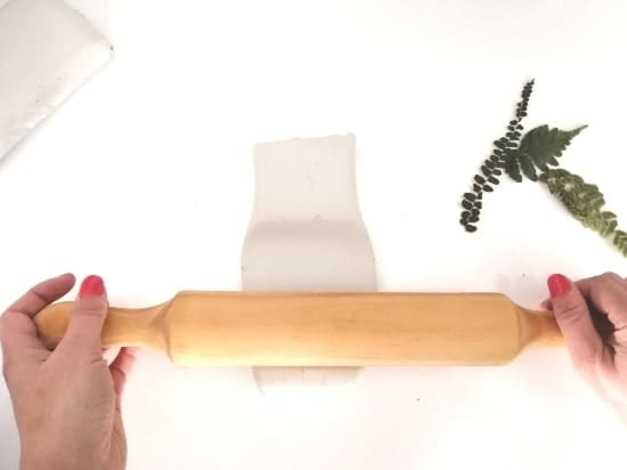
The starting point in how to make homemade clay bonsai pots is to roll out the air-drying clay with a rolling pin. Since it is usually laid out in blocks, we will have to reduce its height considerably. In order for our vase to be strong, it will be enough that the layer of clay is a little more than half a centimeter.
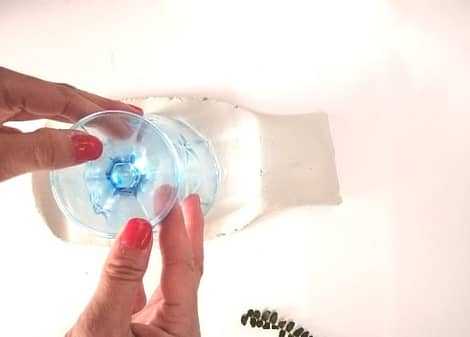
With our clay prepared and spread out, we will cut a part of the plate that we will dedicate to the base. We’ll mark the clay with a specific depth using a cup, glass, or bowl with a standard edge. Despite being able to extract the base from the rest of the mixture, it may stick to the walls and be difficult to separate.
To avoid this, the idea is to mark the circumference that we want and finish cutting that piece with a knife.

With our two pieces prepared, it is time to transfer the leaves to the surface of what will be our homemade clay bonsai pots without an oven. We will begin by placing them loosely on the plate until we see which is the final design that we like the most.
For the drawing to have more dynamism, it is advisable to play with different sizes. Once we have decided on the layout, we will pass over the roller to fix the silhouettes on the clay.

After a couple of hours, it is time to finish assembling our homemade and original bonsai pot. Helping us with water, which will act as glue, we will join the plate with the base. It is important to place special emphasis on gluing the joints between the two pieces so that they join properly.
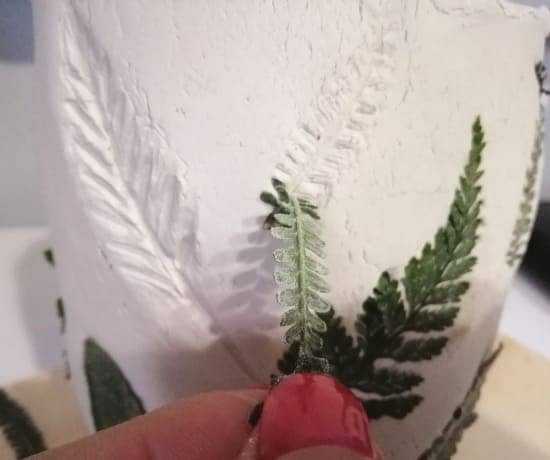
When the points of union between the base and the walls of our homemade pot with clay have dried, it is time to carefully remove the attached leaves.
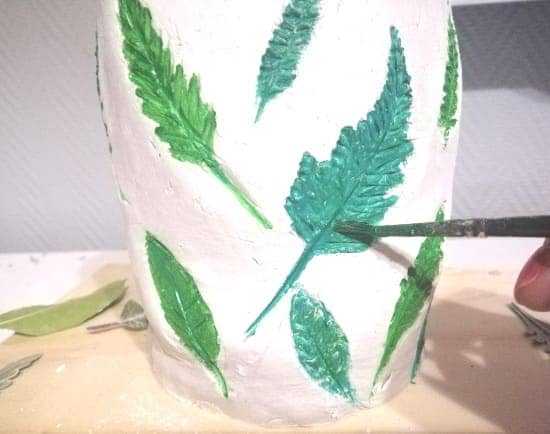
We only have to paint our leaves after having our silhouettes stamped on the clay.
And ready! Our homemade and original pot is ready to decorate the place we choose for it. A different and personal way of making our plants even more beautiful.
Hopping Bonsai Pot
The Hopping Bonsai Pot in Minecraft is a unique item that lets you place items right in its bottom inventory. You can also use the Hopping Bonsai Pot to drop items from your inventory below it. You can use this item to decorate your pot with dye, which works with any type of pot. Some trees require specific types of soil, so the type of soil you use can make a big difference in the growth of your Bonsai. The Dye feature works on both the normal and the Hopping Bonsai Pot.
First, place the Bonsai Pot in a suitable open space. Then, plant a compatible sapling on the pot by right-clicking it. Your tree will grow, and when it’s fully grown, you can harvest it with an axe. The Hopping Bonsai Pot has an upgrade slot that allows you to place axes. These axes can be enchanted with Efficiency, Fortune, and Silk Touch, and will harvest the trees for you.
The Bonsai Trees 2 Mod is a convenient mod that adds Bonsai Pots to Minecraft. You can plant small trees in these pots and harvest them for specific tree drops. This mod is compatible with vanilla Minecraft, Pam’s HarvestCraft, and IndustrialCraft 2. Additionally, it allows you to customize the growth multipliers for each tree and their drops.
Step-by-Step Guide on Making a DIY Bonsai Pot
Making a DIY bonsai pot doesn’t have to be difficult or time consuming. With some basic tools and supplies, you can easily create your own custom container for your bonsai tree. Here is a step-by-step guide on how to make a DIY bonsai pot at home.
The first thing you’ll need to do is measure and cut the pieces of material that will form the base of the bonsai pot. Depending on what type of material you are using, you may need to use different techniques such as drilling, sawing, sanding, etc. Once all of the pieces have been cut and shaped properly, they should fit snugly together into the desired shape and size of the pot.
Next, it’s time to attach each piece together with adhesive or nails if necessary. Before attaching everything permanently though, consider painting or decorating your container in any way that appeals to you – this can really make your homemade pot stand out from store bought versions. Once all of the pieces are attached together firmly, it’s ready for planting!
To complete your DIY project, add drainage holes at the bottom of your container if they’re not already present so excess water can escape when watering your plant. This is an essential part in preventing root rot which can occur when plants sit in too much moisture for too long a period of time. After adding these small details to ensure adequate care for your bonsai tree inside its new home, enjoy showing off your beautiful creation – one that was made entirely by you.
Frequently asked questions
How do I choose a bonsai pot?
You should choose a pot that is proportional to the size of the bonsai tree. The pot should also have good drainage and should be made from a material that won’t absorb too much moisture.
How do I position the bonsai tree in the pot?
Position the tree so that the root ball is centered in the pot. Make sure to leave enough space in the pot to accommodate the trunk and any branches.
How do I secure the bonsai tree in the pot?
Use bonsai wire to secure the tree to the pot. Start by wrapping the wire around the trunk and then wrap it around the root ball. The wire should be wrapped tightly but not so tightly that it cuts into the tree or the roots.
What Color Should My Bonsai Pot Be?
There aren’t specific rules for choosing a Bonsai pot color. As we covered earlier, a Bonsai tree’s pot should channel its energy, whether feminine, masculine, or somewhere between.
If you want your Bonsai pot to be a fun color or pattern, try to incorporate similar tones from your tree, like finding one that matches its flowers or leaves.
Bright Colored Bonsai Pot
Here we have a bright yellow Bonsai pot idea that is very cheerful. Although this tree is tiny, we appreciate how this Bonsai grower chose to go with a rounded pot to balance the curved shape of the tree’s trunk and branches.
Patterned Bonsai Pot
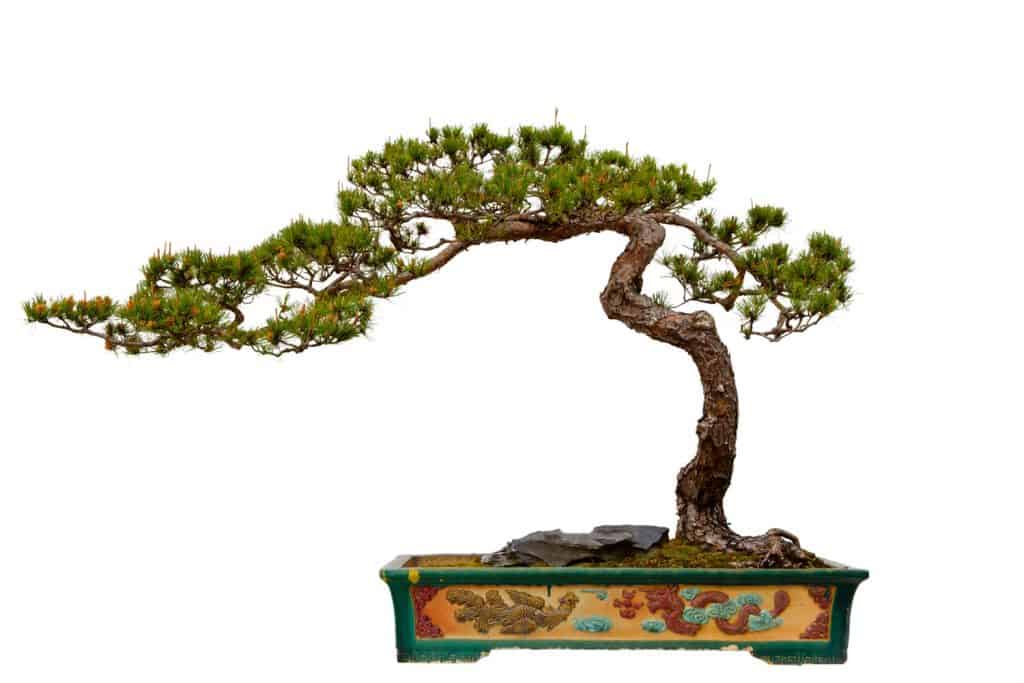
Another idea for your Bonsai is a patterned pot similar to this example. Regardless of whether your tree falls into masculine or feminine energy, we think using patterns is always a fun way to spice things up.
Защита от вредителей
1. Инспектируйте регулярно
Периодически проводите осмотр своей бонсай плитки, особенно на обратной стороне листьев и в углах горшка. Определите вид вредителя и принимайте меры для его уничтожения.
2. Поддерживайте чистоту
Мусор и остатки растительных материалов на поверхности почвы — это идеальная среда для размножения вредителей. Регулярно очищайте горшок и удаляйте отмершие листья и другие органические отходы.
3. Используйте натуральные препараты
Для борьбы с вредителями на бонсай плитке предпочтительно использовать натуральные и безопасные препараты. Например, можно обрабатывать растение настоем чеснока или раствором мыла. Некоторые виды бонсай реагируют на хорошо ароматизированный настой полыни, золы и перца.
4. Защитите от проникновения
Окружите свою бонсай плитку преградой, чтобы предотвратить проникновение вредителей. Особенно внимательно следите за дренажной системой и замшей горшка, где насекомые могут скрываться.
5. Контролируйте влажность
Избегайте избыточной влажности, которая может привести к появлению вредителей, таких как клещи и тли. Регулярно проверяйте уровень влажности в почве и поддерживайте ее на оптимальном уровне для вашего конкретного вида бонсай.
Следуя этим рекомендациям по защите от вредителей, вы сохраните свою бонсай плитку в отличном состоянии и сможете наслаждаться ее красотой на протяжении продолжительного времени.
Planning for Creating Your Own Bonsai Pot
Planning for creating your own bonsai pot is the key to success. You must know what tools, materials and processes you will need before starting. To create a beautiful, high-quality container for your tree, you should make sure that you have all of the necessary items on hand.
First, it is important to determine what kind of pot you want to construct. There are many different styles available in various sizes and shapes. Consider if the pot should be round, oval or square; shallow or deep; ceramic or terracotta; etc. Make sure that whatever shape and type of material you decide on fits with the unique aesthetic needs of your plant’s species.
You will also need certain tools and materials depending on which type of potting technique you choose: either traditional Japanese plastic wrap rooting method or foam tape wiring technique. Gather basic supplies such as garden hose clamps, foam tape strips, suitable sized plastic sheeting and scissors before getting started so that there won’t be any frustrating delays in between steps due to lack of equipment. Having extra pieces of material nearby in case something goes wrong can really come in handy when making repairs mid-project as well.
Обзор Bonsai Pots
Bonsai Pots – новые растения в горшках
В игре Minecraft можно не только строить или бродить по шахтам, участвовать в PvP-битвах с другими игроками, но еще и просто заниматься садоводством, быть флористом, так как по умолчанию здесь предостаточно разных видов цветов, которые могут быть украшением вашего дома внутри или снаружи. Только вот стандартные виды в Майнкрафте не всегда устраивают игроков, и они предпочитают устанавливать отдельные текстурпаки, где был бы изменен внешний вид этих растений.
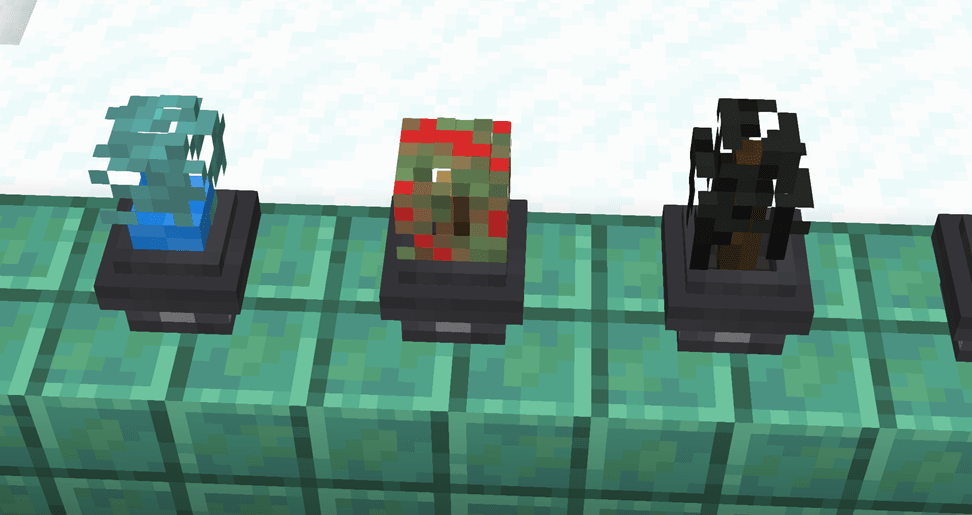
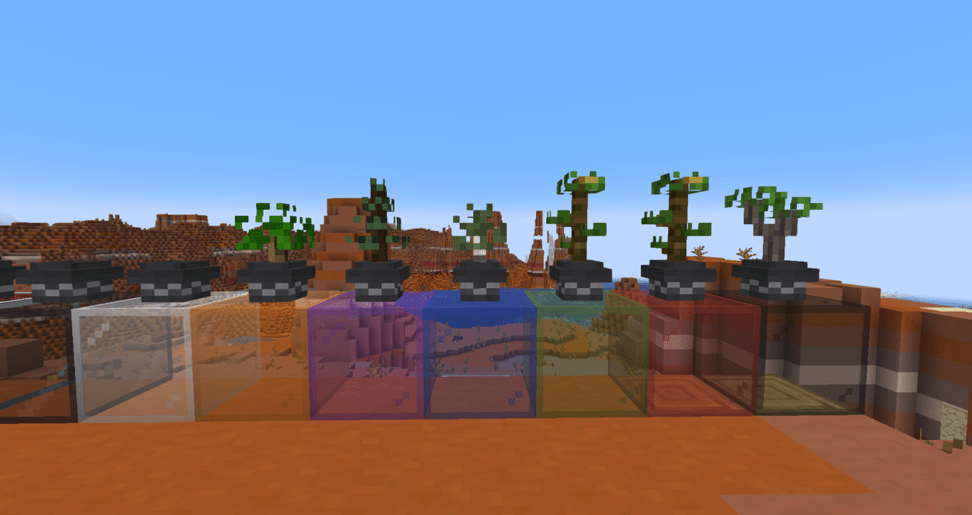
Если вы один из таких пользователей – рекомендуем посмотреть детальный обзор текстурпака Bonsai Pots, позволяющий в пару кликов получить совершенно новые виды для цветов в Minecraft, выполненные в китайском стиле «бонсай». Смотрится ярко, необычно, классно. В кубическом мире подобного раньше вы точно не видели, а сам пак меняет только текстуры растений, не трогая при этом других стандартных блоков и предметов из игры, поэтому вполне может сочетаться с разными текстурами.
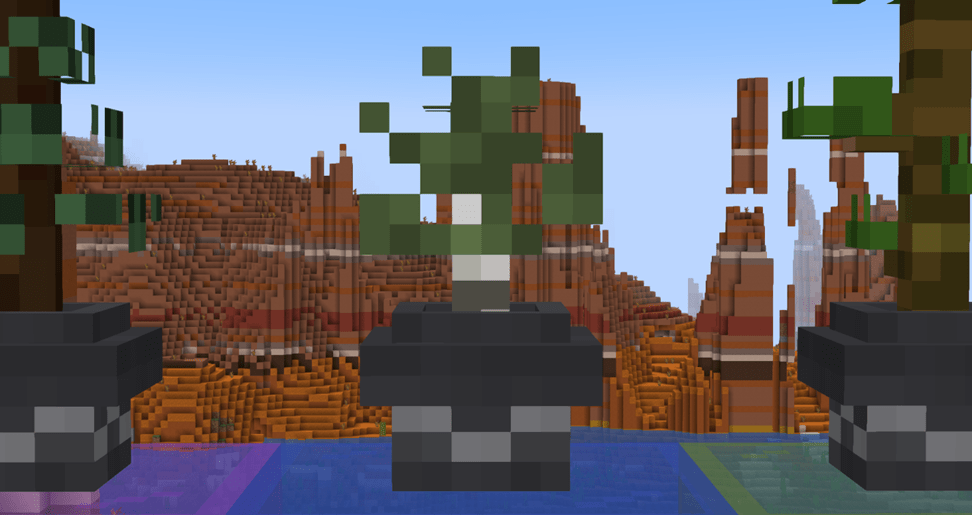
Обзор текстурпака Bonsai Pots
Установив данный текстурпак, китайский стиль буквально в пару кликов поменяет стандартный внешний вид цветов в горшках. Этот пак можно использовать вместе с модом OptiFine для установки шейдеров, которые еще больше добавляют эффектов и улучшают графику Майнкрафта. Например, очень хорошо будет дополнять картинку динамическое освещение или тени, появляющиеся от горшков с цветами, в зависимости от времени суток. А если у вас будет большой сад, то картинка преобразится еще больше.
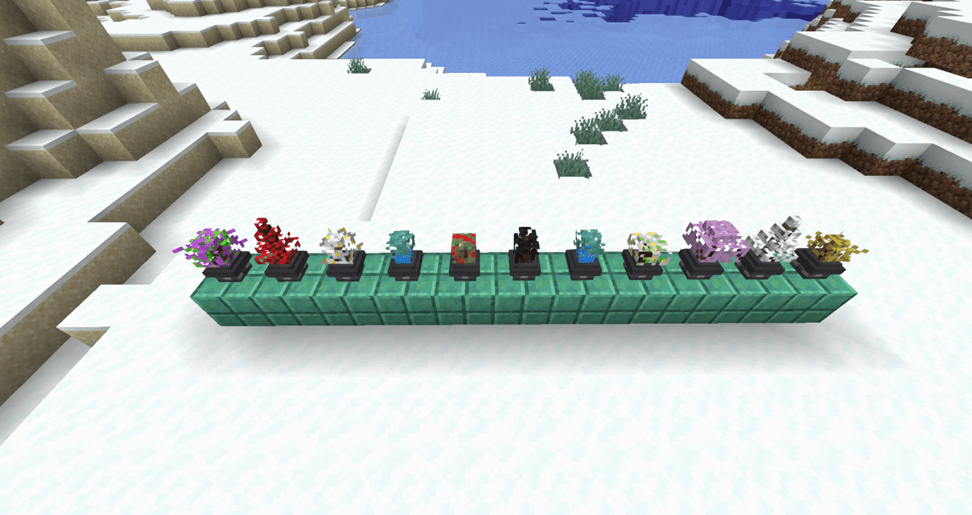
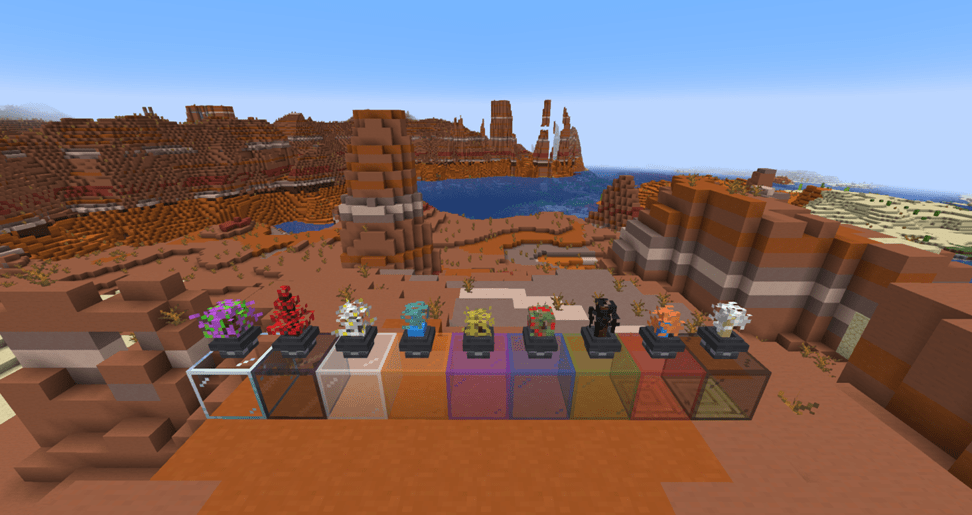
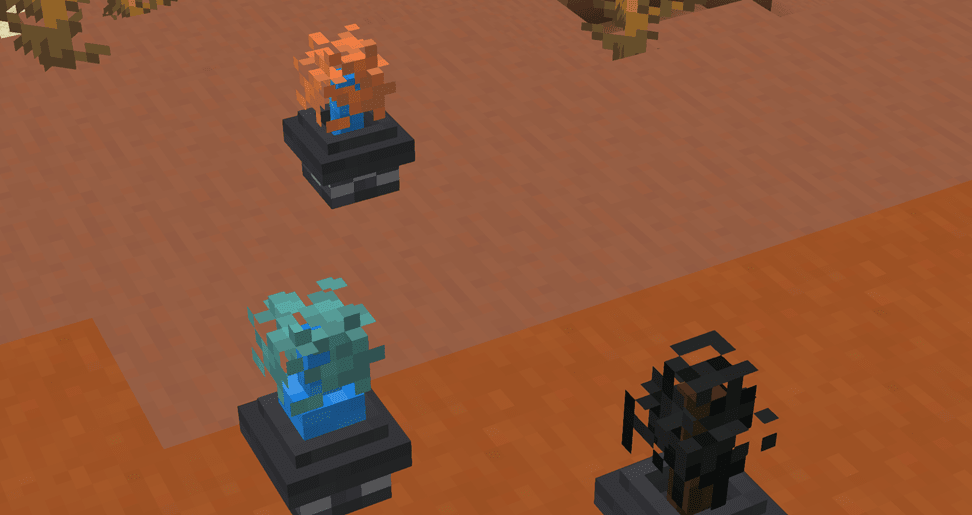
Меняется внешний вид всех цветов в игре: тюльпаны всех цветов, ландыши, роза визера, василек, орхидея и все остальные. По своей текстуре большая часть из них будет схожа между собой, так как выполнена в стиле «бонсай», поэтому на экране вы увидите квадратный вариант цветка, будь то василек или тюльпан. Не совсем правдоподобно, если сравнивать с реальными прототипами растений, но вполне интересно и необычно смотрится, особенно для кубического мира Minecraft.
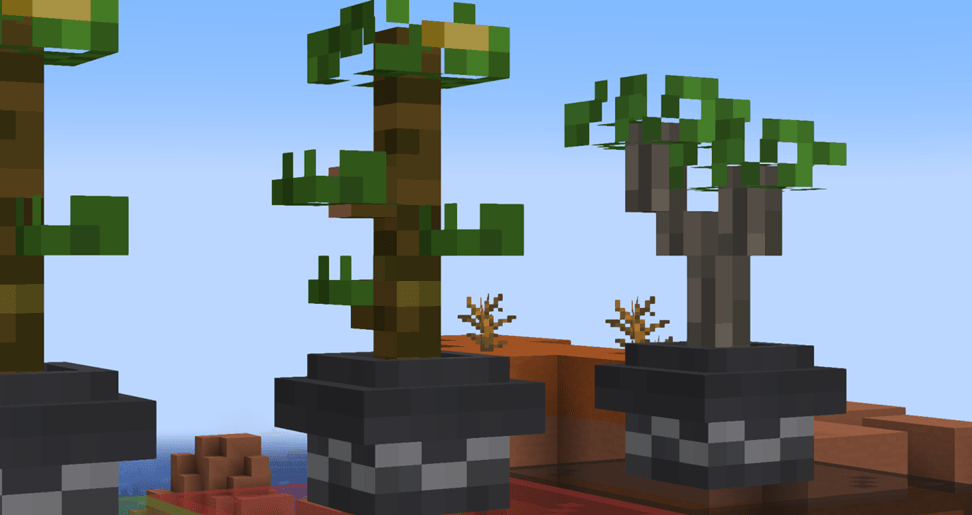
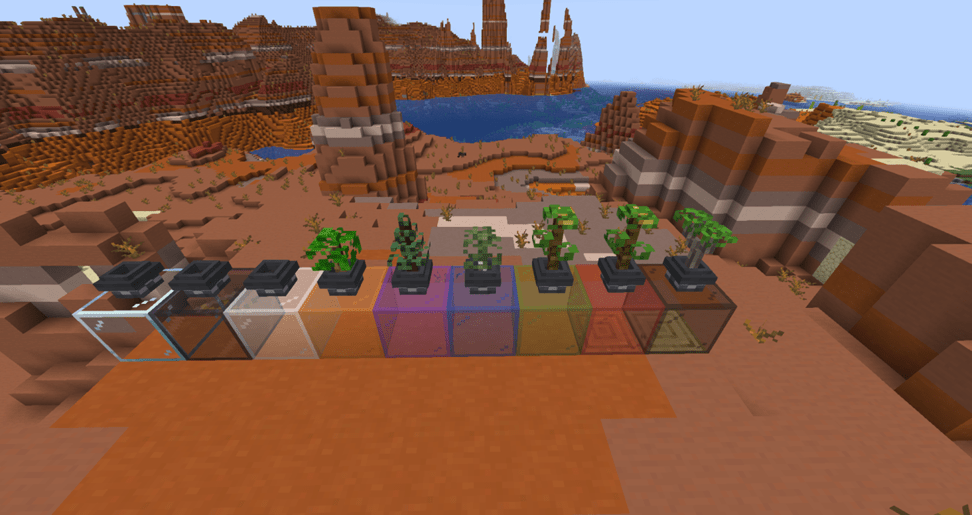
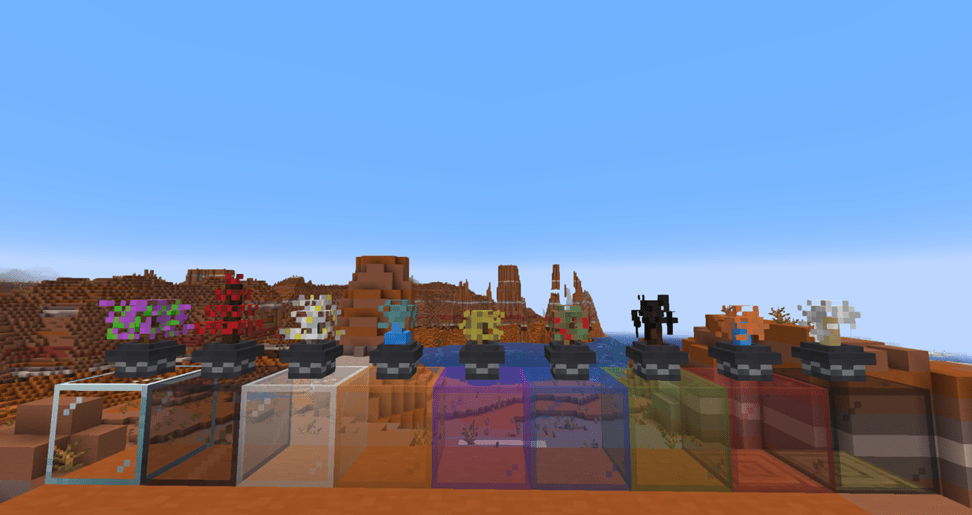
Если будете использовать горшки для деревьев, то их тоже можно будет преобразить, используя для этого текстурпак Bonsai Pots. Он преображает каждое дерево в квадратный стиль, сильно отличающийся от стандартного варианта «ванильного» Майнкрафта, поэтому на экране вы увидите вот такие вот деревья в горшках, как представлены на наших скриншотах. На самом деле выглядит стильно, и такие варианты текстур встречаются не так уж и часто. Автор проработал каждое растение, дерево, все это выполнил в одном едином стиле.
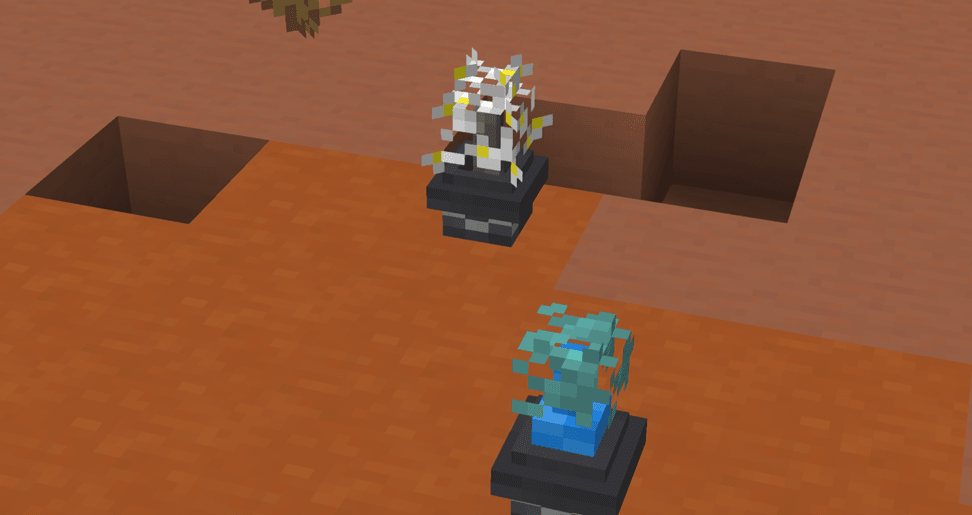
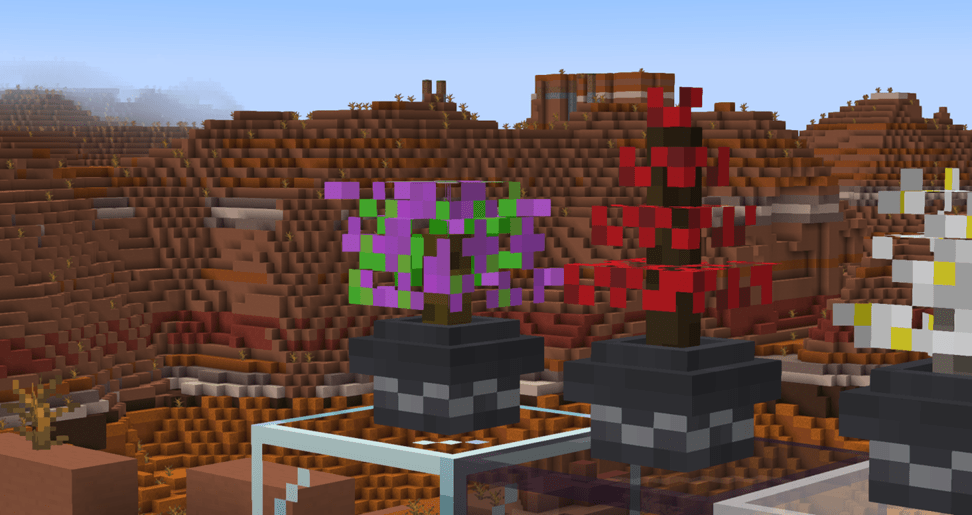
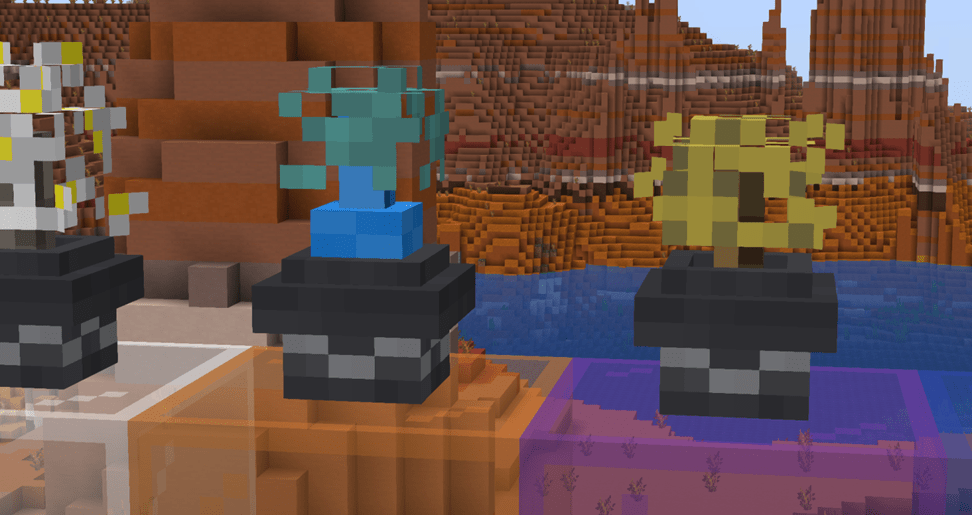
Использовать горшочки с растениями можно для украшения интерьера, чего явно не хватает в стандартной версии игры. Если хотите построить красивое строение не только внутри, но и снаружи, установите текстурпак Bonsai Pots и преобразите все растения. Также можно создать и своего рода сад, где будут расти деревья, разные виды цветов, выполненные в стиле «бонсай». И здесь вам тоже поможет этот пак, включающий в себя столько изменений и дополнений, нововведений. Сделали для вас большое количество дополнительных скриншотов, чтобы показать, насколько это круто и красиво.
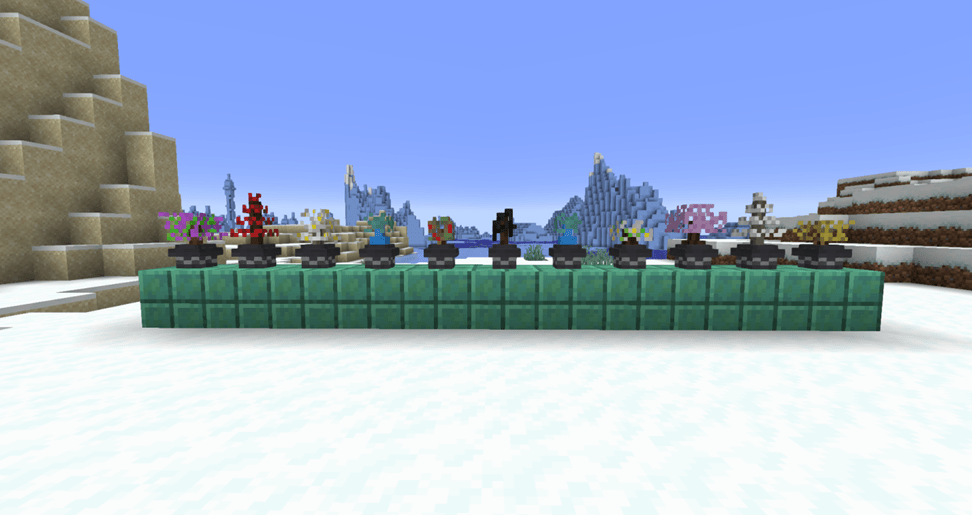
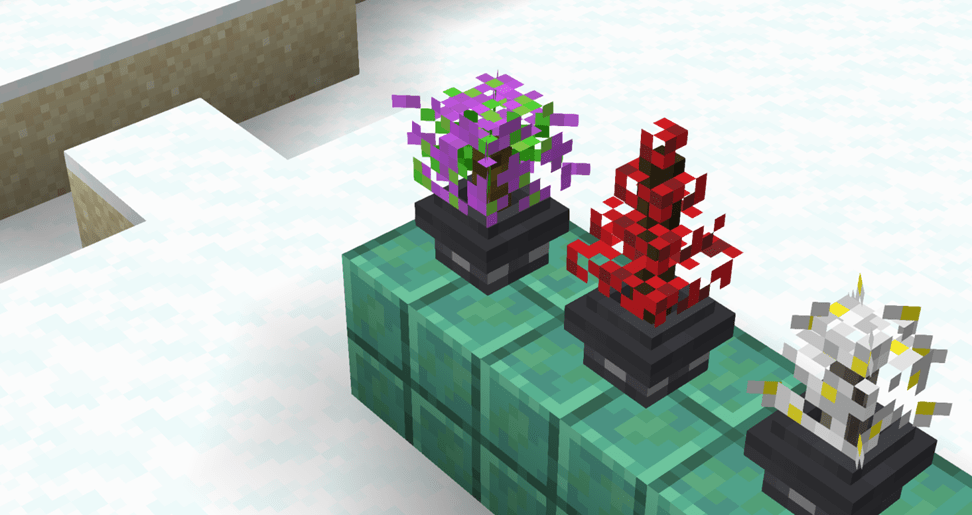
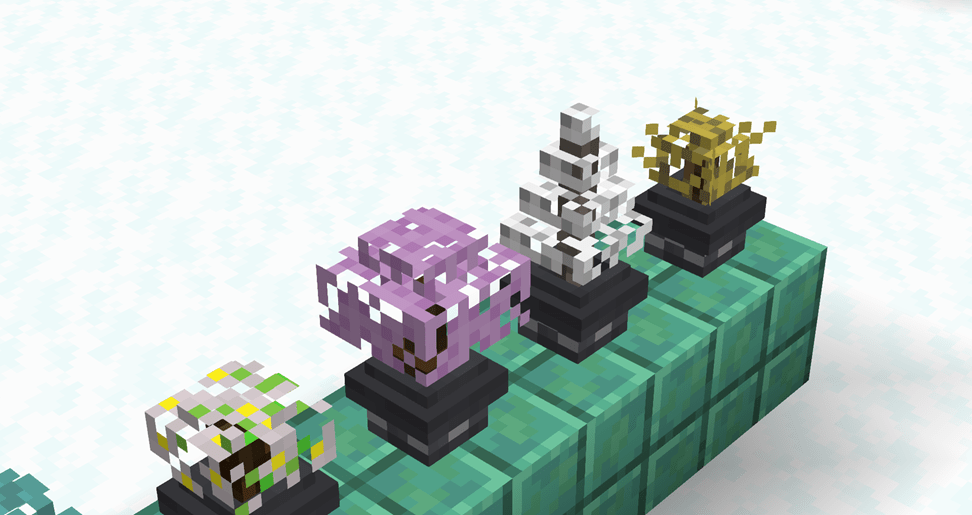
По итогу можно сказать, что этот текстурпак относится к категории «на любителя», но при этом он качественно выполнен, проработаны все растения, добавлены интересные варианты, сохранен единый китайский стиль
И самое важное – текстурпак Bonsai Pots отлично работает с OptiFine, может быть установлен вместе с другими паками, меняющими внешний вид блоков или предметов в игре Minecraft. Не нагружает ваш компьютер, работает стабильно практически на любой версии, поддерживает все растения из 1.19.2 и более ранних версий
Alternative Methods to Make Your Own Bonsai Pot
If you want to make a bonsai pot, but don’t feel like taking the traditional route of buying one, there are alternative methods that can give great results. One method is by using hypertufa. This material consists of equal parts peat moss, portland cement and fine gravel which can be shaped into your desired shape and then sealed with an epoxy resin sealer or silicon rubber sealant when dry. Using this mixture will help the pot acquire an aged look while still keeping it lightweight enough to move around without a problem.
Another option for making a bonsai pot would be to build one out of wood. This requires more skill, as you’ll need to craft the design yourself and also ensure that it fits in within the necessary dimension guidelines for a bonsai tree’s root system. If done correctly though, it could last multiple generations with simple maintenance every once in awhile such as staining and varnishing. Some woodworkers enjoy working on projects like these so much they even sign their work.
Caring for a Bonsai Tree
Now that you’ve hopefully settled on a cultivation method and/or picked a kit, let can talk a bit about caring for your Bonsai tree.
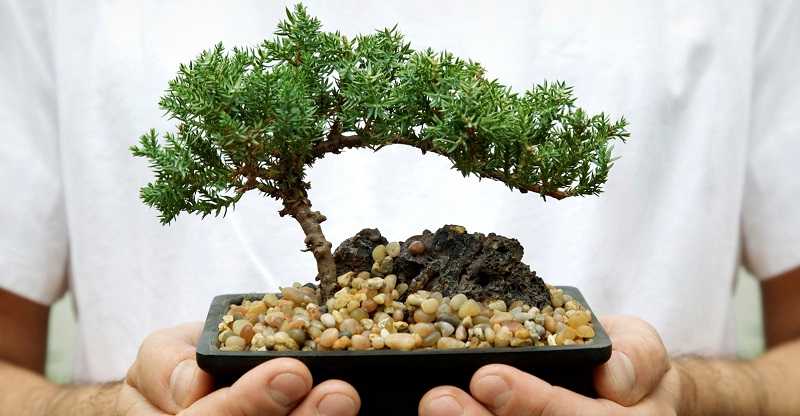
Light
If growing your Bonsai tree indoors, you need to make sure it gets plenty of light. Usually, the density of light inside the house is far lower than outside and, in time, will lead to stunted growth.
So, if you’re growing your Bonsai indoors, place it in front of a window facing the south, so that it gets plenty of light. Ideally, you can supplement this with specially designed plant-friendly fluorescent lighting for several hours a day.
Soil
You can either buy special Bonsai soil or make your own. When choosing the right soil for your Bonsai, you want to look for one that can hold water but that also encourages drainage (this is why mixing it with lava rocks of gravel is a good idea).
Temperature
While most Bonsai trees handle heat well, many of them are sensitive to cold and frost. Most Bonsais require a minimum temperature of 55 degrees Celsius during the colder months and some may need to be placed near a heat source to maintain moisture. But this varies a lot from species to species.
Water
Many Bonsai owners are guilty of under-watering, mainly because Bonsais generally take up fairly little soil and so dry out rather quickly. For most types of Bonsai trees, it’s a good idea to water them when the top-most layer of soil appears dry.
Watering frequency depends both on the type of soil and species of Bonsai you’ve chosen. Some require watering once a day or even more than that, while others only need watering every few days.
Fertilizer
You want to choose a fertilizer rich in Potassium, Nitrogen, and Phosphorus, with other nutrients like Iron, Boron, Zinc or Copper making for welcome additions. Make sure to fertilize your Bonsai throughout its growing season (e.g. early spring through early autumn).
How to fertilize: If using solid fertilizer for an outdoor Bonsai tree, place the right amount of fertilizer (check label) in a cup (ideally one with small holes in to allow air) that will protect it from birds. Place the cup face down at a slightly crooked angle from the root of the Bonsai. If using liquid fertilizer, apply it when you water the Bonsai.
Pruning
You will want to do regular maintenance pruning, which involves snipping away young shoots, twigs, and branches to encourage growth.
Pruning frequency and time varies from species to species, but for flowering Bonsais, it’s good to prune them in the spring, to encourage more flowers in the summer.
You can also perform structural pruning, which is done purely for decorative purposes while the tree is dormant. Structural pruning, however, is a fairly complex process. Check the video below for some tips.
Repotting
Repotting is another important aspect of Bonsai culture because excess roots may risk filling the soil and the tree may starve. Depending on how fast your Bonsai grows, you should repot it once every 2-3 years.
Tip: Remove the plant from its pot with great care and gently trim away the outer edges of the roots, keeping an eye out for rot. Before you repot, make sure to clean out the pot until it looks new and layer the bottom of the pot with new soil. Once you’re done, plant the tree on top and merge the new soil layer with the existing tree bed.
Mold or Mildew
Mildew is a fungic growth and can appear as either a white or black substance on the leaves. Once present, Mildew can’t be cured, so you need to remove the affected leaves as soon as possible.Treat mold with a mild pesticide spray, as it’s caused by a pest infestation.
Black Spot
This is a fungus that thrives in dampness, so you must not water the tree until you’ve removed the fungus. Like with mildew, you need to remove the affected leaves as quickly as possible and spray the plant with a fungicide.
Leaf Spot
Very similar to Black Spot, except the spots appear white and progressively darken to brown. Again, you want to remove the affected areas and spray the Bonsai tree with a fungicide.
Instructions for choosing pots
How do you select the right pot for a certain tree? There are a few rules of thumb and guidelines that can help.
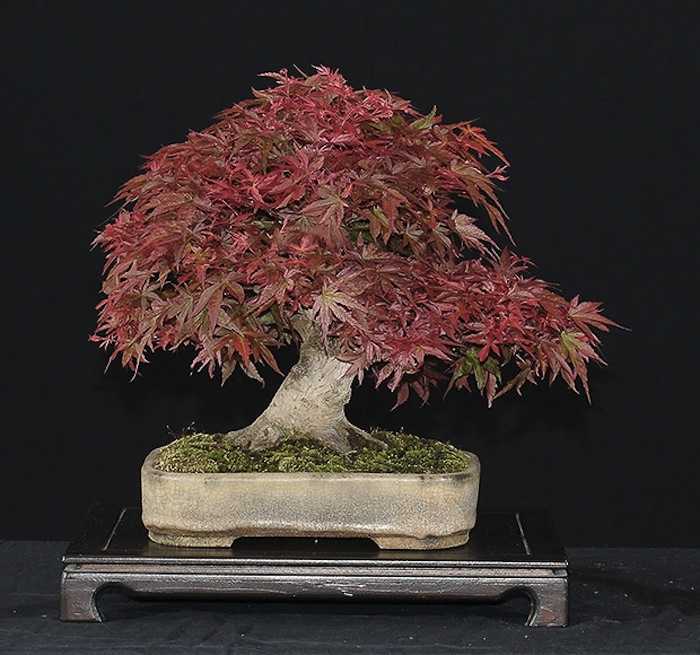
Acer palmatum „Seigen“ in a pot by Gordon Duffett (UK).
The tree should be complemented and framed by the pot, but the pot should not outshine the tree.
Conifers traditionally belong in unglazed pots which can sometimes have specially processed surfaces.
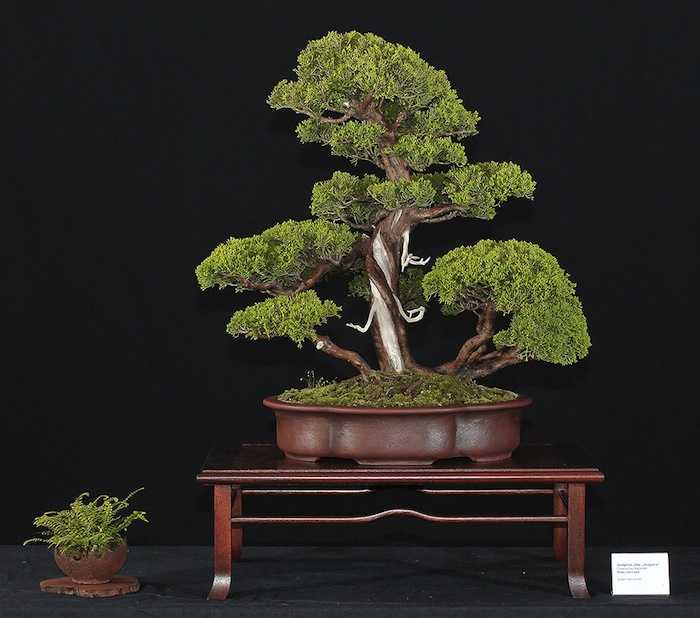
Itoigawa juniper in an unglazed pot with a special surface finish by Peter Krebs.
Broadleaved trees are usually planted in glazed pots with unobtrusive colours while flowering and fruitbearing bonsai can have pots with brighter glaze colours. Very gnarled deciduous trees and those with very rough-bark can sometimes also look good in unglazed pots.
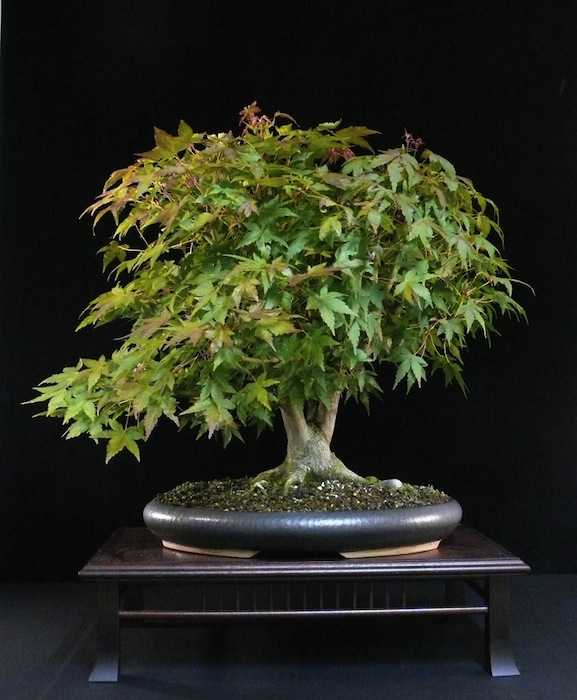
Multitrunk Japanese maple in a glazed pot by Peter Krebs.
The depth of the pot should correspond with the thickness of the trunk base.
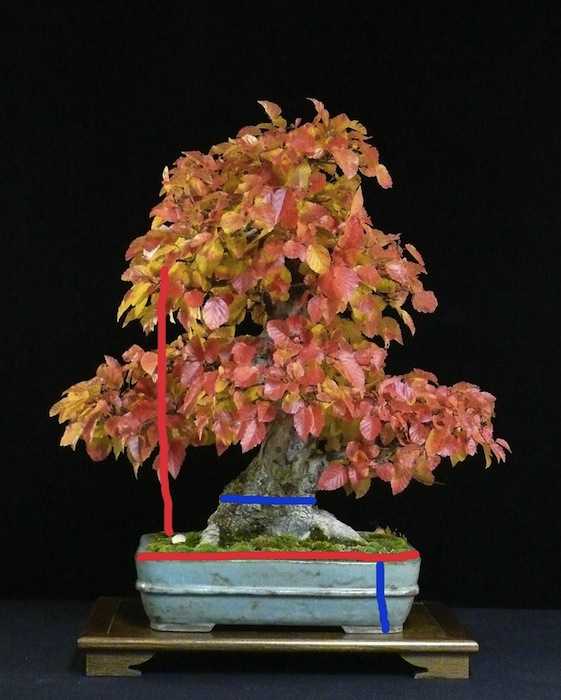
Length of the pot: about 2/3 of the tree’s height (red), depth of the pot: approximately equal to the diameter of the trunk base (blue). Corean hornbeam in a pot by Erwin Grzesinski.
Exceptions are forests and group plantings which are mostly planted in very shallow pots. Cascades and semi-cascades are also an exception as they need deep, heavy pots as a physical and visual counterweight.

Pinus sylvestris cascade by David Benavente in a Tokoname pot.
The pot ought to reflect the shapes of the tree. A lovely deciduous tree, like an informal upright Japanes Maple with a softly curved trunk, always looks good in an oval pot, typically with a pale green, blue or beige glaze.
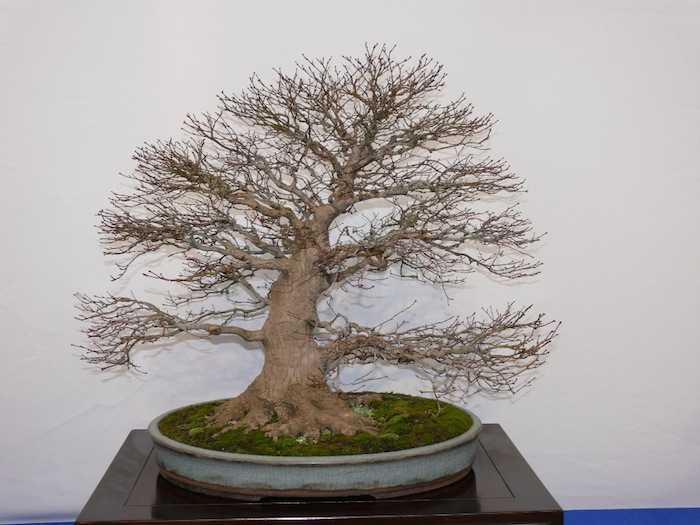
Japanese maple by Udo Fischer in a pot by Gordon Duffett.
A masculine, formally shaped conifer with a massive trunk is in most cases perfectly supported by a rectangular, dark, unglazed pot.
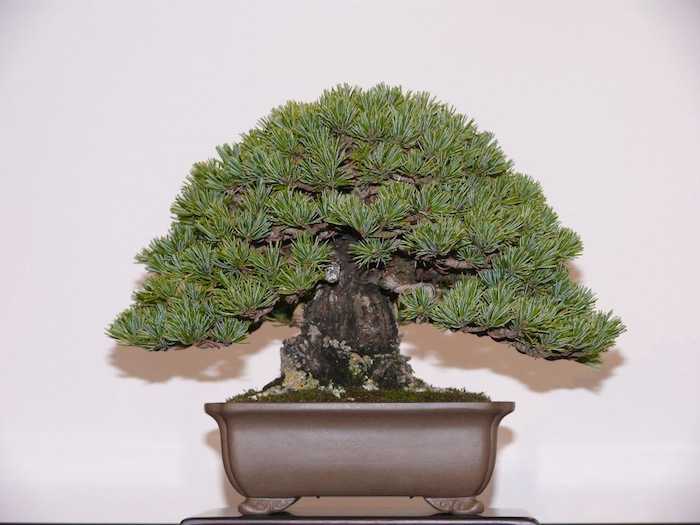
Shohin Japanese white pine by Marc and Ritta Cooper in a dark rectangularTokoname pot.
Informal upright bonsai trees are most often planted in oval pots and formal upright trees in rectangular pots.
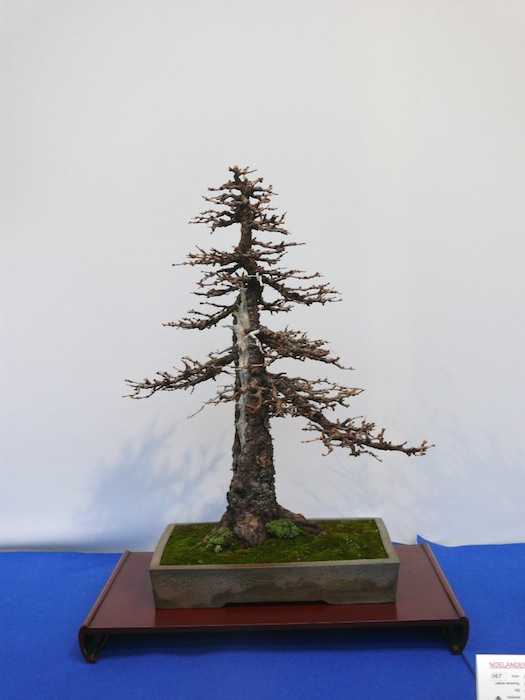
Formal upright larch in a formal rectangular pot at the Noelanders Trophy 2013.
The bunjin style needs a round pot which in most cases is quite shallow and small and can be irregularly shaped, looking primitive (called nanban pots). Some valuable hand made nanban pot can appear so imperfect that you could think the potter just failed to make a good one. But this is not true as those pots are carefully shaped.
They support the beauty of modesty, irregularity and imperfection which can be achieved to a great extent in a bunjin bonsai.

Bunjin pine in a small round pot.
Cascade pots are more or less deep, depending on the length and visual or physical weight of the cascading tree. Their outline is in most cases square, hexagonal, octagonal or round.
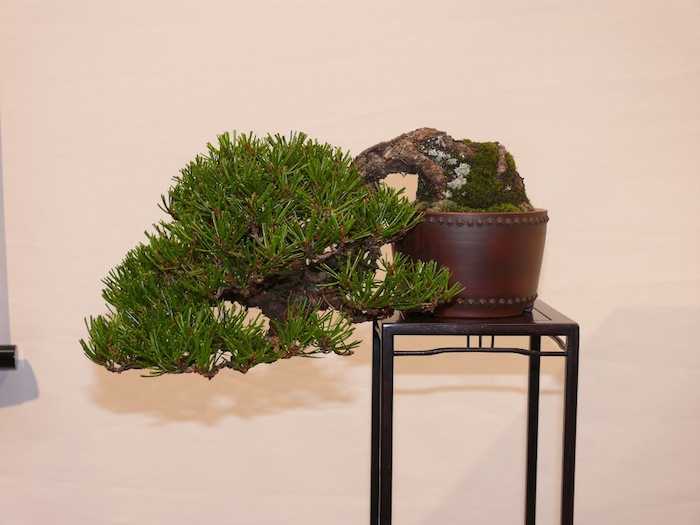
Shohin cascading pine in a round Tokoname cascade drum pot.
Broom styles in most cases are planted in shallow oval or rectangular pots.

Japanese maple in an informal broom style by Walter Pall in an oval large bonsai pot.
Windswept bonsai look very good in shallow oval, rectangular or irregular shaped pots or on stone or ceramic slabs.
Forests, group plantings and raft styles are planted in shallow oval or rectangular pots ore on stone slabs or ceramic slabs.

Spruce forest on a stone slab.
For old Yamadori from the mountains, which often have a breathtaking bark and very individual shapes, some European potters have created lovely rough, fissured surface structures and very unusual pot shapes because those trees are often impossible to classify.

Yamadori pine in an individual pot by Erik Krizovensky.
If you observe the above rules as good as possible in the beginning you won’t make very bad mistakes.To be able to confidently choose suitable pots needs a sure instinct and a lot of experience. It helps to look at many illustrated books of important exhibitions (the Kokufu show in Japan for example) and pay attention to the tree – pot combinations. Reflecting on the intentions of the bonsai artist who chose the pot and what it symbolizes in combination with the tree will get you many useful insights.

Bonsai pot book by Kunio Kobayashi with lots of lovely examples.
If you have become quite secure in pot choice by following the traditional rules and looking at manifold illustrative material, nothing must keep you from trying more unusual and extraordinary combinations.

Unusual red glazed pot by Peter Krebs.
Written by: Heike van Gunst. «Heike van Gunst (from Hamburg, Germany) has been growing Bonsai for more than 30 years. She has gained manifold skills in training and caring for diverse species and has developed a passion for Bonsai pots and Bonsai display. Writing and translating Bonsai articles and Bonsai book translations are her special subject.».
Bonsai tree pot categorization based on shape
Bonsai pot can have numerous shapes. However, most common and popular shapes are listed below:
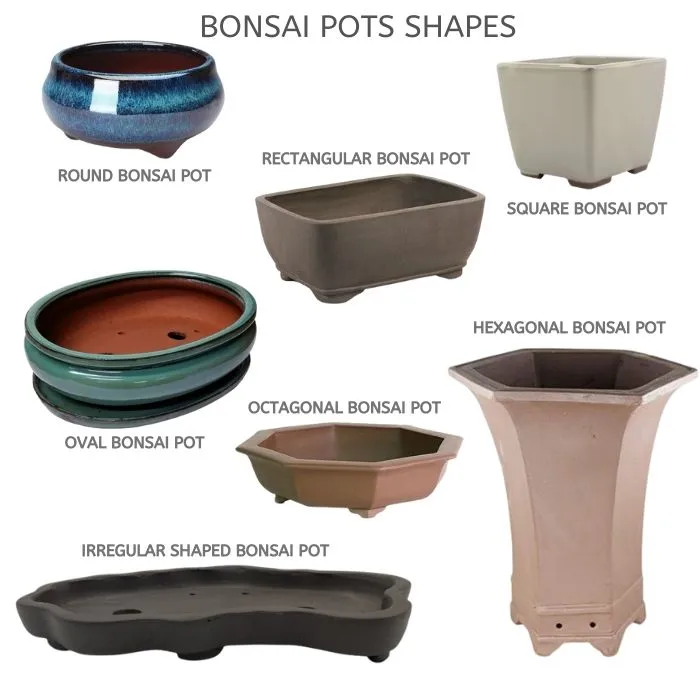
- Round pots – These pots are mostly suitable for trees with thinner and fragile looking trunks. Literati bonsai plants are a good choice for this type of pot.
- Rectangular pots – Heavy trees with thick trunks and branches are best suited to these pots.
- Square pots – Similar to round pots, these pots are also opted for planting bonsai trees with thin trunks. Literati bonsai style.
- Oval pots – Pots with oval shape are generally used for forest bonsai style.
- Hexagonal or Octagonal pots – These pots are a great choice for displaying symmetrical literati bonsai style.
Irregular shape pots – Irregular pots such as crescent pots are mostly used for drift wood or windswept bonsai style.
JSON configuration files
If you want to grow bonsai trees in Minecraft, you can use the JEI configuration files. JEI helps you find compatible saplings, soil, and more. It also lets you know the sapling’s growth progress. Some trees require specific soil types, and some have specific growth boosts for them. JEI allows you to look up compatible saplings and choose them based on their characteristics.
To make the json configuration files compatible with the Minecraft tree type, you first need to create a TreeType definition. This is done by writing a configuration file containing the TreeType shape. Java TreeTypes can automatically generate shapes if the player knows the json configuration file’s format. However, the JSON TreeType requires you to create the tree in the world and save the configuration file.
Bonsai Trees is a mod by Davenonymous. It adds the ability to grow trees within two blocks, and has many additional features. It also allows you to harvest specific tree drops. The mod supports vanilla Minecraft, Pam’s HarvestCraft, IndustrialCraft 2, and Integrated Dynamics. It also allows you to customize tree drops and growth multipliers.
To install the mod on Mac, open the finder on your computer. In the Applications Support folder, look for Minecraft. Then, move the Bonsai Trees 2 Mod into the Mods folder. After you do this, open Minecraft and it should show that the new mod is installed.
Community questions on Bonsai Trees
Again, thank you for sending in your questions and commenting on our posts with your contributions and concerns. Below the most frequently asked questions on bonsai trees we have answered so far!
Which is the best bonsai tree for beginners?
The Ficus Bonsai is one of the best Bonsai trees for beginners if the Ficus. With many different varieties, it is easy to care for and very long-lasting. But there are you should check out.
Are bonsai trees hard to care for?
People tend to assume it’s difficult to care for a Bonsai Tree. It’s not. While some species are rather complex, most are easy to keep once you understand some .
How much is a real bonsai tree?
While you can purchase a variety of small, cheaper Bonsais for around $20-$30, the price of starts somewhere around $100 and can go up to several thousand dollars, with some even raking in millions.
What are bonsai trees good for?
Bonsais are great for many things. Just by looking at one may make you calmer and more productive. Also, a purifies the air in the room.
HOW TO MAKE HOMEMADE BONSAI POTS AND DIFFERENT POTS
When we consider how to make bonsai pots from clay at home, we usually run into several complications. The first one is that this type of clay requires specific manual treatment. Only when it is handled correctly and has the hydration it demands can it be set properly. When both characteristics are not present, our creations tend to break and crack.
But it is not the only impediment when making bonsai pots at home. Added to this, the clay requires a very specific drying at high temperatures and with air. Only with very specific heat conditions will it dry properly.
Avoiding this type of inconvenience involves choosing an alternative material that allows us to make homemade bonsai pots without too much inconvenience. And yes, there is: the answer is the drying of the white clay. A material that will allow us to achieve the result we are looking for without so many shocks.
What Is a Bonsai Tree?
The interesting part here is that while people tend to refer to it as a “Bonsai tree” regardless of its shape, size, etc., there are many types of Bonsai trees, which we will talk about in just a second.
The thing that all these different types of trees share is that they are all cultivated and grown in the same art form—Bonsai (with a big “B”).
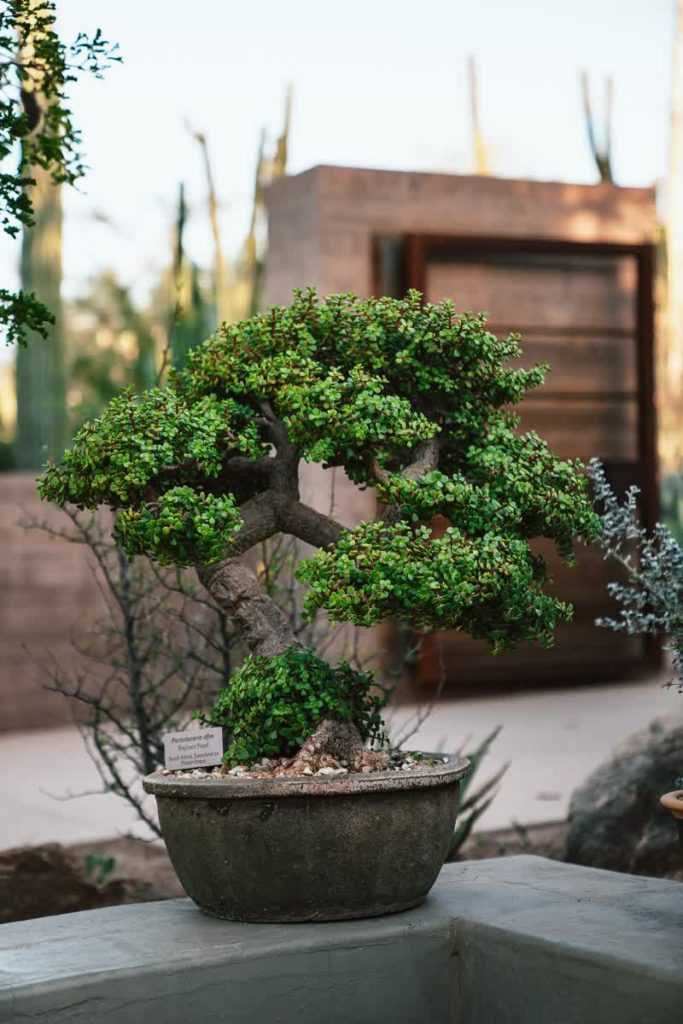
This East Asian art form relies on very delicate and precise growing techniques to recreate a tree in miniature size. Literally, the term “Bonsai” translates to “planted in a container.” And that’s what this art is all about, growing a real-life tree in a pot or container.
The scope of Bonsai tree growing is to offer a sort of tribute to the amazing nature that surrounds us and hold up a mirror to it.
Silk Touch upgrade
The Silk Touch upgrade for bonsai trees is a resource that increases the chance of rare items and special abilities being dropped by trees. The higher the level of this resource, the more rare items will drop from bonsai. However, this resource is not necessary to grow bonsai trees in Minecraft. There are other options, such as a hopper.
The Silk Touch upgrade for bonsai trees has two main effects. The first is that it increases the FE/t of destructor. This makes it easier to build bonsai plants. The second effect is the increased speed of growth of trees. This resource is used by a bonsai enthusiast who wants to cultivate a bonsai in the Minecraft game.
Bonsai Hd Wallpapers
If there are two, it usually means the city and the hearth. The number refers to the potter who works on the pot. In this case, Potter #20. The lower the number, the higher the potter. Number one will be the man or woman who has been there the longest and is the master. At least that’s what I was told.
Today we are going to play #20. Yes, this is a temporary pot until next June at the earliest.
When I put the pot, I pile soil in the middle of the pot to fill the spaces at the root. Screens are like live.
And, of course, it is well bound (which is one way since my clients follow the manufacturer’s specifications) I said. If I am working on a tree, the first thing I look for is a strong tree tied in a pot. If it’s not secure, I’ll add more straps.
Skyfactory 4] Just Another Bonsai Farm
My soil mix at the moment: two parts scoria (lava rock for water, water retention and aeration), one part expanded slate (gray material, today’s brand name is Espoma’s Soil Perfector. This is for clear liquids. It’s in the matrix. retain some water). Part diatomaceous earth (the white stuff, this is for fertilizer storage, CEC, and water retention) and part “small” fir
Best soil for pot plants, potting soil for bonsai, pot for bonsai, soil mix for bonsai, bonsai pot minecraft, best soil for bonsai, best soil for juniper bonsai, bonsai pot and soil, soil for pot plants, best soil for bonsai trees, soil for growing pot, bonsai soil for sale
Harvesting bonsai trees with an axe
The Bonsai Trees mod is a Minecraft mod that adds Bonsai pots to your game. You can plant small trees in these pots to get special tree drops. They also grow in different ways than full-sized trees and can be harvested for materials. Afterwards, you can plant a new tree from the sapling you have just harvested.
To harvest a bonsai tree, you need two blocks of space and a pot. The pot should be placed one block above the tree. Once the pot has been placed, right-click on the pot to harvest it. Once harvested, the bonsai tree will be gone. If you want to keep it, you can plant it again. Just be sure to put a high random tick speed before harvesting.
To use the harvesting method, you must first upgrade the Silk Touch enchantment in your inventory. You can do this by using an enchanted item or book. This will increase the amount of rare drops you can get. In addition to this, it will reduce the time it takes your bonsai to fully grow. The higher your Silk Touch upgrade level, the faster your bonsai will grow.
Before you can harvest a bonsai tree, you must get the right soil. Different types of soil give different boosts to Bonsai growth. Then, you can pot it and start caring for it. You can also update your tree to a Hopping Bonsai and customize its appearance.
Правильная посадка растений
Процесс посадки растений в бонсай плитку требует тщательного подхода и соблюдения определенных правил. Вот несколько шагов, которые помогут вам правильно посадить растение:
1. Подготовьте горшок или контейнер с дренажной системой для посадки растения. Убедитесь, что горшок хорошо промыт и дезинфицирован перед использованием.
2. Подготовьте субстрат для посадки. Он должен быть легким, дренирующим и питательным для растения. Большинство бонсай-субстратов включают в себя смесь глины, песка и органических веществ.
3. Поместите растение в горшок или контейнер, аккуратно распределите корни, чтобы они равномерно расположились
Обратите внимание на тот факт, что корни не должны быть перегибаны или повреждены
4. Заполните свободное пространство вокруг корней субстратом, аккуратно прижимая его, чтобы устранить воздушные карманы.
5. Полейте растение после посадки, убедившись, что вода равномерно проникает через всю горшок. После полива удалите излишки воды из поддона.
6. Разместите бонсай плитку на подходящем месте, где растение будет получать оптимальное количество света и температуру.
7. Не забывайте регулярно ухаживать за растением, проводя надлежащее поливание, подкормку и обрезку, чтобы обеспечить его здоровый рост.
Следуя этим простым шагам, вы сможете правильно посадить растения в бонсай плитку и наслаждаться их красотой на протяжении долгого времени.











![Bonsai pots на майнкрафт скачать [все версии/обзор]](http://vvk-yar.ru/wp-content/uploads/1/d/4/1d417a6f7729598c95b0a263c8594a6f.jpeg)







![What's the best pot for bonsai trees? [inc. 11 perfect examples]](http://vvk-yar.ru/wp-content/uploads/3/1/c/31cd21ce2c277fed216a0b8369ab492a.jpeg)









